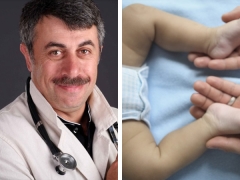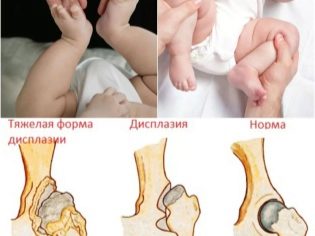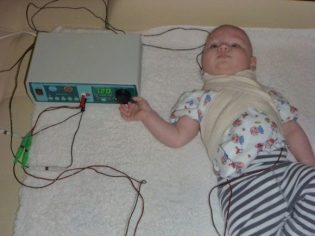Dr. Komarovsky about hip dysplasia in children
The situation in which doctors diagnose a hip dysplasia in a newborn is, alas, not uncommon today. Such a threateningly sound diagnosis scares and discourages parents. Dr. Yevgeny Komarovsky tells what to do if the child was placed.
About the disease
Hip dysplasia is a joint defect in which it is more mobile than a normal joint. This leads to dislocation or subluxation. In the world, the disease is quite common. In Scandinavian peoples with such a defect, about 4% of children are born, and in the USA - about 1%. In Russia - 2-3% of babies have dysplasia of the hip joint, and among the Chinese and Africans there is practically no such disease.
In countries where it is still customary to swaddle the straightened legs of an infant, the incidence is higher than among nations in which swaddling is not practiced.
Pathology in girls is more common than in male children. According to medical statistics, such a disease is recorded in children who were in a pelvic presentation, as well as in children - the firstborn. The left joint is affected more often than the right. In 20% of cases, both left and right are affected.
In case of hip dysplasia, the head of the femur cannot physiologically be kept in the joint capsule. With a slight exit from the cavity, doctors talk about subluxation, with full dislocation of the hip.
An experienced doctor will see dysplasia at the first examination of the infant, usually it is performed in the first few days after discharge from the hospital.
The doctor will be able to suspect the pathology of the following symptoms:
- Skin folds on the legs are asymmetrical, uneven.
- Hip kid shortened.
- When the doctor tries to separate the legs in different directions, there is some restriction of movement. The breeding angle is also different.
- When breeding and mixing the legs, a distinct click is heard.
All these signs can be observed in perfectly healthy children, and therefore none of them is not an independent basis for diagnosis. Need x-ray, ultrasound, orthopedic examination.
Treatment of mild forms can be limited to wide swaddling, breeding legs, massage and gymnastics. If the form is more complicated, the doctor recommends orthopedic devices, for example, Pavlik's stirrups. In some cases, surgical treatment or bloodless reposition of the joint with subsequent fixation complex is recommended.
"Hip dysplasia in children" - should young parents be afraid of such a diagnosis? More on this in his own program by Evgeny Komarovsky.
Komarovsky about the problem
Evgeny Komarovsky argues that modern orthopedists tend to exaggerate the problem and make diagnoses even in doubtful cases, even with minor doubts.
The fact is that 20% of babies in varying degrees from birth suffer from different forms of hip joint defect. Real dysplasia is much less common, and 2-3 cases out of 1000 require serious treatment.
Evgeny Komarovsky refuses to consider the disease congenital, since all elements of the joint are in place, and the softening and stretching of the ligaments are most often caused not by a defect in the structure, but by the hormonal background of the mother, who in the late stages of pregnancy produces hormones that soften and stretch the ligaments for an easier generic process.
In the overwhelming majority of cases, according to Evgeny Komarovsky, no treatment is required, and after some time the joints return to normal in a completely natural way. Tight swaddling, genetic predisposition can interfere with this natural process (if parents had similar problems in their childhood).
Additional risk factors, according to Komarovsky, are the age of the mother - after 35 years old, congenital deformity of the baby’s feet, birth weight more than 4 kilograms.
Children born prematurely deserve special attention from pediatricians and orthopedists, as well as toddlers whom mothers bore in “extreme” conditions - with strong toxemia, while taking various medications, even if the drugs were prescribed by the woman’s doctor. Children at risk of multiple pregnancies are also at risk, as well as babies whose mothers worked in hazardous industries during gestation or live in ecologically unfavorable regions (there can be up to 12% of such diagnoses).
The earlier the existing instability of the joint is found, the better, Komarovsky believes, because the younger the child, the easier it is to correct his problem with the joints. Up to 4 months you should not do an x-ray study, it is quite a harmless and informative method of ultrasound.
Treatment and Prevention
Where there is no culture of swaddling, for example in Africa, children from birth are worn in the pose of riders tied to their backs. And they did not even hear about dysplasia there, says Komarovsky. This posture will help to correct defects in the structure of the joint, and will also be an excellent prevention of hip dislocation.
You can wear a child diapers a size larger than it should be, so that his hips always remain slightly divorced. Therapeutic massage is very effective with a minor stage of the disease.
Komarovsky advises parents not to sound the alarm and not to panic. Hip dysplasia requires them to be consistent and measured actions. With pre-emergence, you can get by with massage and electrophoresis, with a subwoofer, the doctor will insist on wearing orthopedic stirrups, while dislocating - tires. Operatively, the problem is solved if the diagnosis is made late or the severity of the joint damage is great.
Yevgeny O. does not advise moms and dads to refuse treatment, because the lack of therapy will not always have a positive effect in the future. A child may develop habitual lameness, pain in the pelvic joint and its deformity, the muscles of the legs may atrophy to one degree or another, in severe cases, the organs located in the pelvis may lose all or part of their functions.
Many of these consequences are disabilities. Therefore, it is better to take measures to prevent such a development scenario at a very early stage.
Tips
-
It is not necessary to encourage a child with a diagnosis of hip dysplasia to early standing and walking. It will be better if the pussy first learns to steady and crawl perfectly.
-
The most effective treatment is considered to be about one year old.
-
Any treatment, other than surgery, makes sense up to 5 years. After this age, it is not possible to talk about any other therapy, except for surgery.
























